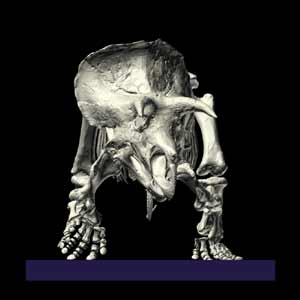 |
NEW EXHIBIT
In May, 2001, the Smithsonian National Museum of Natural History
will unveil a new mount of Triceratops. This new skeleton
is a product of traditional bone replication by molding and casting,
and three-dimensional laser scanning and prototyping that fixes
many inaccuracies in the original mount. The posture of this skeleton
is also new, arrived at by prototyping an accurate and handleable
miniature of the skeleton that scientists analyzed bone by bone.
Triceratops is the first digital dinosaur, existing accurately
in the computer, and able to be shared with researchers as easily
as e-mail. This new approach and new Triceratops will tell
us many more things about how this three-horned dinosaur lived
and moved over 65 million years ago.
|
|
|
What's in a Name?
The Smithsonian's Triceratops is now named
Hatcher, in honor of John Bell Hatcher, the collector who
found our fossil in 1891.
Why do we name fossils? A personal name acknowledges
that dinosaurs, like people, are individuals.
Jarek Buss, ten years old, from Laramie, Wyoming,
wrote the winning essay that named Hatcher.
|